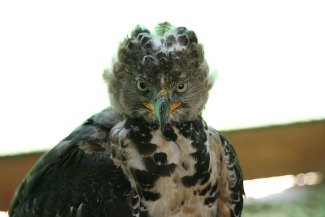Crowned Hawk Eagle - Stephanoaetus coronatus
By William H. Majoros, CC-BY-SA-3.0, via Wikimedia Commons
Family: Accipitridae
Genus: Stephanoaetus
Species: S. coronatus
Crowned Hawk Eagles are some of the largest eagles in Africa and considered to be the most powerful. They live in a variety of habitats throughout much of sub-Saharan Africa.
Physical Description:
Crowned Hawk Eagles are black from above except for a dark brown head and wing patches. The undertail is gray with two broad black bars and a wide black subterminal band tipped with white. Underwing coverts are chestnut, with bold dark barring on flight feathers. The breast is cream, rufous, or buff with heavy black mottling and streaking, and the abdomen has black bars. Females are more rufous, and have heavier barring. The feet are large and powerful, with long talons. The beak is dark gray with an orange gape-flange (where the upper and lower mandibles meet). The eyes are pale yellow. They have a double crest, a long tail, and broad, rounded wings.
Juveniles are gray-brown from above. The head and underparts are white, though the breast is rufous when they first leave the nest. They reach full adult plumage after six years.
Crowned Hawk Eagles are highly vocal birds, calling in flight and when at the nest; a series of calls can continue for up to 20-30 repetitions. Listen to a recording.
They can live up to 15 years.
Size:
Length: 81-99 cm
Wingspan: 180 cm
Weight: Male: 2.7-4.1. Female: 3.1-4.7
Habitat and Distribution:
Crowned Hawk Eagles live a range of habitats, including lowland and montane evergreen forest, rainforest, dense woodland, forested ravines and gorges, open savanna, tree plantations, and thornveld, from 0-3,000 meters above sea level and higher.
By Jon Mountjoy, CC-BY-2.0, via Wikimedia Commons
They are rare to uncommon within their range and thinly distributed throughout sub-Saharan Africa. They live in western Africa from Senegal and Guinea-Bissau to Cameroon, Republic of the Congo, Democratic Republic of the Congo, and Gabon; in eastern African through western Ethiopia, eastern Sudan, Uganda, Kenya, and Tanzania; and in southern Africa through Zambia, Malawi, Mozambique, South Africa, and Swaziland. Their total range is 6,610,000 km². Adults sedentary, but juveniles disperse from breeding areas. There are approximately 1,000-10,000 individuals.
Diet and Hunting:
Crowned Hawk Eagles are the most powerful of all African eagles. They are known to take antelope such as duikers and klipspringers more than six times their size; the rest of their diet includes monkeys and other primates, rodents, hyraxes, mongooses, large lizards, game birds, and sometimes carrion.
They hunt by swooping down on their prey from a perch and catching it on the ground, although tree-dwelling animals may be taken in flight or knocked to the ground. Larger prey is divided up and may be hidden in surrounding trees to be eaten later. The raptors have been known to hunt in pairs and will share what they catch. Monkeys are sometimes caught using a method where one eagle flies overhead in the canopy, causing the troop to emit alarm calls which exposes their position. Another eagle then catches any stragglers who remain in the open.
Reproduction:
Breeding displays consist of dives and swoops, which are usually done by the male. If the female joins him, they may claw-grapple—where the female rolls over in flight and presents her talons to the male. They may also lock their feet together and cartwheel through the air.
The nest is built out of sticks and lined with green leaves, and it can be up to 2.5 meters wide and 3 meters deep. Most of the building is done by the female, taking around 5-6 weeks. It is placed in the fork of a tree 12-40 meters high, or on a cliff if there are no suitable trees in the area. 1-2 eggs are laid and incubated for 48-51 days by both parents, though the female does the majority. Siblicide, also known as Cainism, is common in Crowned Hawk Eagles, and the first chick to hatch almost always kills the second. Fledging takes 90-125 days, with males flying ten days earlier than females. Juveniles remain dependent on their parents for 350 days after fledging. Due to that dependency, adults are only able to breed every other year.
By Tom Tarrant, CC-BY-SA-3.0, via Wikimedia Commons
Conservation:
Crowned Hawk Eagles are widespread, but are threatened by habitat loss, deforestation, shooting, trapping, and nest destruction. They have been listed as Least Concern by BirdLife International.
Taxonomy:
Based molecular sequences of one nuclear and two mitochondrial genes, Stephanoaetus coronatus has been shown to be genetically divergent from other booted eagles. It is the only member of the genus Stephanoaetus, for S. mahery (Malagasy Crowned Eagle) became extinct when humans settled in Madagascar.
Other Names:
African Crowned Eagle, Crowned Eagle, Kroonarend (Afrikaans and Dutch), Orel korunkatý (Czech), Kroonkotkas (Estonian), Keisarijalokotka (Finnish), Aigle Couronné (French), Kronenadler (German), Aquilastore coronato (Italian), Kammurikumataka (Japanese), Kronørn (Norwegian), Wojownik wspanialy (Polish), Águila Coronada (Spanish), Tai Kumbakima (Swahili), Kronörn (Swedish), isiHuhwa (Zulu).
Other Multimedia:
References:
http://www.arkive.org/crowned-hawk-eagle/stephanoaetus-coronatus/
http://avibase.bsc-eoc.org/species.jsp?avibaseid=1E3B3515F00E331A
http://www.biodiversityexplorer.org/birds/accipitridae/stephanoaetus_coronatus.htm
BirdLife International (2011) Species factsheet: Stephanoaetus coronatus. Downloaded from http://www.birdlife.org on
19/11/2011.
Global Raptor Information Network. 2011. Species account: Crowned Hawk-eagle Stephanoaetus coronatus. Downloaded from
http://www.globalraptors.org on 19 Nov. 2011
http://www.planetofbirds.com/accipitriformes-accipitridae-crowned-eagle-stephanoaetus-coronatus
Ferguson-Lees, James, and Christie, David A. Raptors of the World. Houghton Mifflin Company, 2001.


